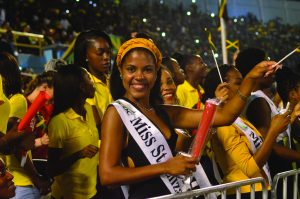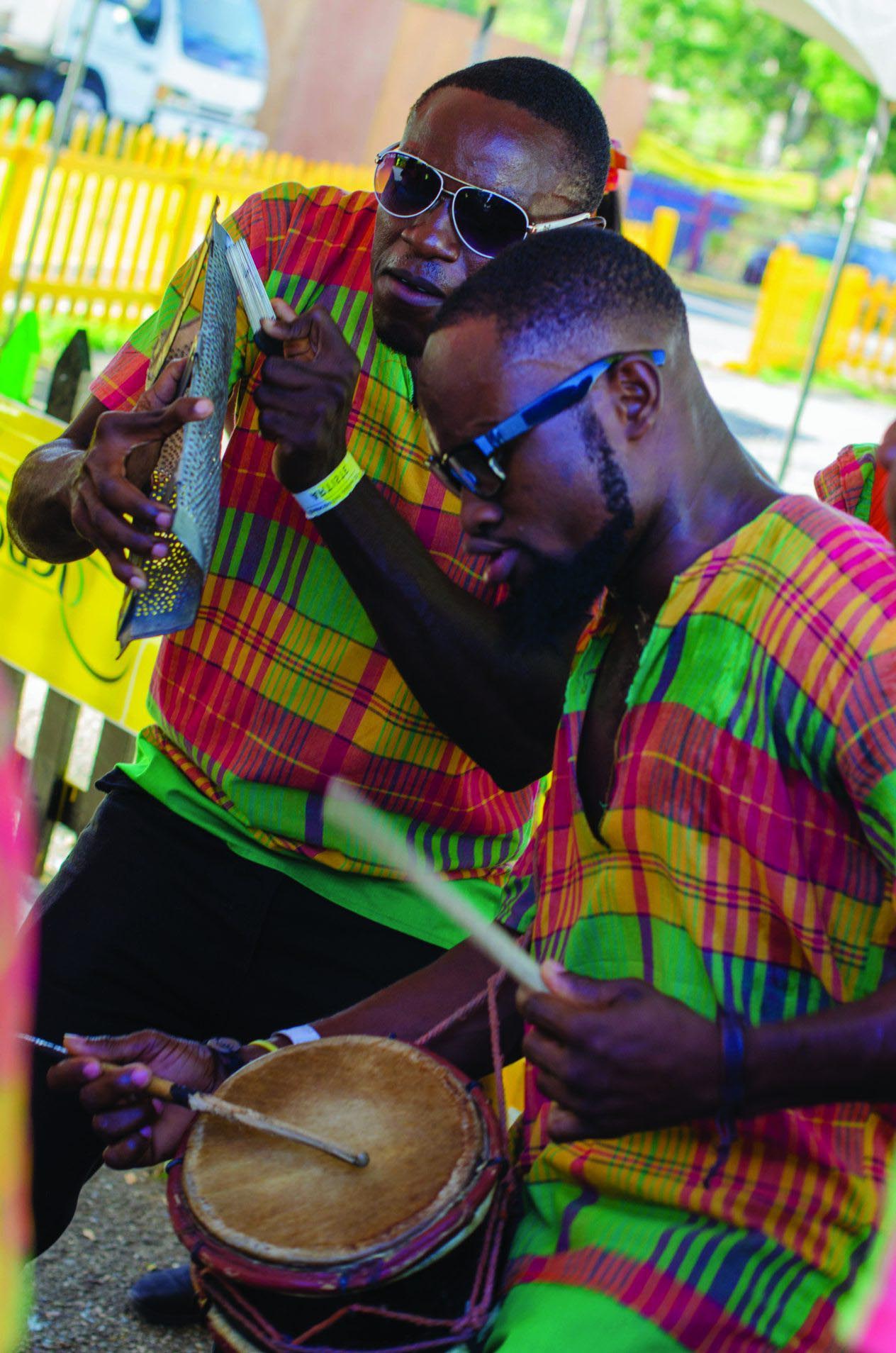It is that time of year again when you get to feast on all the roast yam, asham and snow cones you can devour; you can hear the steady rhythmic drumming of Kumina, dinki mini and gerreh and bask in the sights and sounds of authentic maypole, quadrille and other folk dances. Yes, it is Festival time!
This year marks our 55 anniversary of independence and the celebrations planned are said to be hyped with enough variety for seniors right down to those who still suck their fingers. BUZZZ Magazine sought to take a trek down our cultural memory lane when blue draws, ‘Bustmante backbone’ and bandana ruled supreme.
Conceived to celebrate the essence of what makes our culture both colourful and creative, Jamaica Festival highlights the best of the best of what is ‘yard’ from Negril to Rocky Point and all road side stops in between.
The then Minister of Development and Welfare the Hon. Edward Seaga, developed a cultural plan of action that would appeal to visitors as well as Jamaicans from all walks of life. So from 1963 when it was introduced, festival was embraced as our first cousin and welcomed into our communities, schools and homes. Many of us have fond memories of performing at the regional and then national level, wearing costumes and make-up, reciting and dancing to pieces we practice ad nauseam for months until we could do it in our sleep.
 Designed to further the development of a fledging nation by providing Jamaicans with a sense of belonging as well as pride, Jamaica Festival was for everyone, belonged to everyone and opened to everyone. Not even a disability would have a child on the sideline as there would be competitions for the deaf, and ageism was never a factor as senior citizens could often be seen on stage with gyrations and moves that belied their chronological clock.
Designed to further the development of a fledging nation by providing Jamaicans with a sense of belonging as well as pride, Jamaica Festival was for everyone, belonged to everyone and opened to everyone. Not even a disability would have a child on the sideline as there would be competitions for the deaf, and ageism was never a factor as senior citizens could often be seen on stage with gyrations and moves that belied their chronological clock.
According to then Minister Seaga, Festival celebration were supposed to ‘mobilise the spirit of the people’ hence in 1968, he formalised the proceedings and establish the Jamaica Festival Commission. In 1980 another bill was passed in parliament converting the Festival Commission into the Jamaica Cultural Development Commission (JCDC).
Few know however that our rich legacy of cultural celebrations actually began long before our independence, and according to the Gleaner archives, our rich legacy of food, art and folk forms harken back to the late 19th century. On record, creative competitions were held at the Institute of Jamaica (IOJ) which once housed a miniature zoo. In 1897, the IOJ staged an event to commemorate Queen Victoria’s 60th year on the throne. There were competitions held islandwide in vocal and instrumental music, art and craft, poetry and performance and even essay writing. Sadly the great 1907 earthquake brought an end to that round of events.
As the nation, particularly Kingston was rebuilt, so too were cultural competitions and all-island elocution contests and music festivals were organised, though being under British rule, the contests’ content was decidedly English in nature for the most part. Interestingly, records show that in 1910, a young man by the name of Marcus Garvey represented his parish of St. Ann in elocution and won third place.

From 1930 to the 1950s, the island was rife with social upheaval and legislative change as the sons of former slaves demanded more say, the right to vote, better wages, better education and the recognition of their own heritage. Consequently the Jamaica Welfare Limited was established and competitions for art, craft, plays, preserves and traditional dance were held, though many were based in our capital city. That all changed with the introduction of the 1946 Portland Festival which was a week-long event geared at bringing students and adults together at the inter-school and inter-village levels to compete in a variety of themes and genres, thus commencing a movement that quickly caught on like a wild fire, first in St. Catherine, then St. Ann, followed by Manchester. Culture was becoming a recognised commodity.
To Read More: Purchase your copy of Volume 9 #3– July-August 2017


Share this post:
It is that time of year again when you get to feast on all the roast yam, asham and snow cones you can devour; you can hear the steady rhythmic drumming of Kumina, dinki mini and gerreh and bask in the sights and sounds of authentic maypole, quadrille and other folk dances. Yes, it is Festival time!
This year marks our 55 anniversary of independence and the celebrations planned are said to be hyped with enough variety for seniors right down to those who still suck their fingers. BUZZZ Magazine sought to take a trek down our cultural memory lane when blue draws, ‘Bustmante backbone’ and bandana ruled supreme.
Conceived to celebrate the essence of what makes our culture both colourful and creative, Jamaica Festival highlights the best of the best of what is ‘yard’ from Negril to Rocky Point and all road side stops in between.
The then Minister of Development and Welfare the Hon. Edward Seaga, developed a cultural plan of action that would appeal to visitors as well as Jamaicans from all walks of life. So from 1963 when it was introduced, festival was embraced as our first cousin and welcomed into our communities, schools and homes. Many of us have fond memories of performing at the regional and then national level, wearing costumes and make-up, reciting and dancing to pieces we practice ad nauseam for months until we could do it in our sleep.
According to then Minister Seaga, Festival celebration were supposed to ‘mobilise the spirit of the people’ hence in 1968, he formalised the proceedings and establish the Jamaica Festival Commission. In 1980 another bill was passed in parliament converting the Festival Commission into the Jamaica Cultural Development Commission (JCDC).
Few know however that our rich legacy of cultural celebrations actually began long before our independence, and according to the Gleaner archives, our rich legacy of food, art and folk forms harken back to the late 19th century. On record, creative competitions were held at the Institute of Jamaica (IOJ) which once housed a miniature zoo. In 1897, the IOJ staged an event to commemorate Queen Victoria’s 60th year on the throne. There were competitions held islandwide in vocal and instrumental music, art and craft, poetry and performance and even essay writing. Sadly the great 1907 earthquake brought an end to that round of events.
As the nation, particularly Kingston was rebuilt, so too were cultural competitions and all-island elocution contests and music festivals were organised, though being under British rule, the contests’ content was decidedly English in nature for the most part. Interestingly, records show that in 1910, a young man by the name of Marcus Garvey represented his parish of St. Ann in elocution and won third place.
From 1930 to the 1950s, the island was rife with social upheaval and legislative change as the sons of former slaves demanded more say, the right to vote, better wages, better education and the recognition of their own heritage. Consequently the Jamaica Welfare Limited was established and competitions for art, craft, plays, preserves and traditional dance were held, though many were based in our capital city. That all changed with the introduction of the 1946 Portland Festival which was a week-long event geared at bringing students and adults together at the inter-school and inter-village levels to compete in a variety of themes and genres, thus commencing a movement that quickly caught on like a wild fire, first in St. Catherine, then St. Ann, followed by Manchester. Culture was becoming a recognised commodity.
To Read More: Purchase your copy of Volume 9 #3– July-August 2017
Share this post: